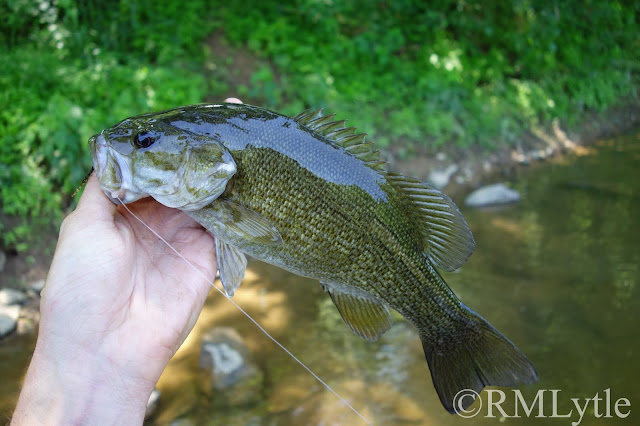Thank you to my Patrons; Erin, David, John, Elizabeth, Brandon, Christopher, Shawn, Mike, Sara, Leo, C, Franky, Geof, Luke, and Noah for making Connecticut Fly Angler possible. If you want to support this blog, look for the Patreon link at the top of the right side-bar in web version. I truly would not be able to keep this going without you wonderful folks!
Our story begins in the cold, damp, soil of a forest in the Mid Atlantic. In this soil stirs an alien creature with big eyes, monstrous looking legs, and a thick abdomen. He has been in this dirt for most of his life, but that is about to end. Something draws this little alien creature upward, right to the surface, where he then climbs up the nearest tree trunk. He then leaves his subterranean shell in favor of a perhaps even more alien, winged form. This little black, orange, and red bug then flies up into the tree canopy and begins to... scream. He screams as loud as he can. In time he is joined by thousands, then millions of his own brethren, creating a deafening chorus.
These little creatures are periodical cicadas (also known as magic cicadas), and they do this every 17 years. They are not all the same species. Three different cicada species make up Brood X, which emerged to breed, lay eggs, and then die this spring throughout large parts of the Mid Atlantic and Midwest. The event is a special one that would be interesting even if the bugs didn't end up creating some very unique fishing. Towards the end of the show I made my way south, seeking the cicadas and everything else occurring in the wake of their chaotic emergence. I'd been fascinated by periodical cicadas long before I'd ever picked up a fly rod, and this was to be a very exciting trip for one totally obsessed nature nerd.

I made it a substantial distance into Maryland before I encountered the first periodical cicadas. Near the town of Thurmont I began to see cicadas flying around. I stopped and found a bunch of dead ones in a parking lot. It was a cold morning, a lot chillier than the cicadas seemed to prefer, so I wasn't yet hearing their trademark singing.
I wandered around for a while before I found both a huge number of cicadas and fish actively feeding on them. I was on a river I'd fished years ago but a part of it I hadn't visited back then. There was a substantial clay bank with overhanging trees creating shade at a bend. The current was lazy and the surface slick. Fish were sporadically rising to cicadas drifting down the river.
Some of the bugs struggled, flailing on the surface and buzzing in an agonizing sort of way. Some just succumbed and floated unmoving. Not every cicada was eaten by a fish, but there wasn't much pattern to the feeding. Sometimes a flailing bug was the target, sometimes a still one. At times cicadas floated through unmolested for five minutes, maybe more. At other points not a single one made it past the catfish and bass that were in there.
Catching these fish wasn't as easy as I would have liked. Precise drifts and long casts in tight quarters were necessary. Hooking the catfish also took some experience I didn't yet have- how often can you find channel cats free-rising for insects to practice on? It certainly isn't their most common feeding behavior. I missed many, but caught plenty as well. Catfish on dry flies... this was exactly the sort of thing I'd made the drive for.
The smallmouth present in the spot weren't quite as gung-ho about the cicadas as the catfish, which may have been because the were smaller and were already about to pop; they were so full of bugs they all looked like little footballs.
After seemingly depleting that source of active fish, I decided to explore a small tributary nearby to see if it might harbor some species I'd not yet caught. Just up from the mouth was a chub mound occupied by a pair of average sized river chubs, a species I'd first caught last summer in western Pennsylvania. I didn't have real micro fishing gear with me, so wasn't equipped to catch the dace and darters that were around the mound.

I continued upstream hoping to encounter some mounds with other species, or perhaps fish schooled in a deep pool. I found both. In fact, a lot of fish were on mounds in this little creek. Most were river chubs, with a few super colorful common shiners mixed in. I was having a hard time catching anything but did eventually get a fairly run-of-the-mill small river chub. Since that isn't a species we have in Connecticut, it was cool to catch one again.
All the while, the cicadas were screaming in the tree canopy. It was loud and constant, and would soon follow me even when there were no cicadas singing around me.
I eventually found another chub mound loaded with fish and began working it. I caught a small river chub, then the largest and most unusual looking fish in the school took my nymph. A gnarly looking male of whose identity I wasn't sure of at the time came to hand. I now know it was a Central stoneroller, a quite trick species to catch on hook and line let alone on the fly, and a new species for me. My 180th life list fish was a totally unexpected one!
 |
| Lifelist fish #180, Central stoneroller, Campostoma anomalum. Rank: Species |
With a satisfying and surprise lifer out of the way, I continued on my quest for fish chowing on periodical cicadas. Now I was looking for carp. It would prove to be a very rewarding challenge.
Until next time,
Fish for the love of fish.
Fish for the love of places fish live.
Fish for you.
And stay safe and healthy.










Great read. Those fish were making the most of that cicada hatch it appears. Glad you connected with some.
ReplyDeleteThanks!
DeleteCatfish on dry flies and another lifelist fish. Sounds like a good trip.
ReplyDeleteIt certainly isn't the most common occurrence.
DeleteWhat a great way to start this post - I felt like I was settling in to a really good story, which I was. Glad you had a good time in Maryland.
ReplyDeleteThank you!
Delete